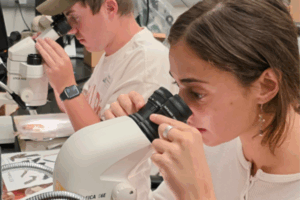second highest-energy cosmic ray ever
In 1991, the University of Utah Fly’s Eye experiment detected the highest-energy cosmic ray ever observed. Later dubbed the Oh-My-God particle, the cosmic ray’s energy shocked astrophysicists. Nothing in our galaxy had the power to produce it, and the particle had more energy than was theoretically possible for cosmic rays traveling to Earth from other galaxies. Simply put, the particle should not exist.

John N. Matthews standing beside large telescope mirrors at the Telescope Array Project's florescence detector station. Credit: Joe Bauman. Banner Photo Aboe: Artist’s illustration of the extremely energetic cosmic ray observed by a surface detector array of the Telescope Array experiment, named “Amaterasu particle.” OSAKA METROPOLITAN UNIVERSITY/L-INSIGHT, KYOTO UNIVERSITY/RYUUNOSUKE TAKESHIGE
The Telescope Array has since observed more than 30 ultra-high-energy cosmic rays, though none approaching the Oh-My-God-level energy. No observations have yet revealed their origin or how they are able to travel to the Earth.
On May 27, 2021, the Telescope Array experiment detected the second-highest extreme-energy cosmic ray. At 2.4 x 1020eV, the energy of this single subatomic particle is equivalent to dropping a brick on your toe from waist height. Led by the University of Utah (the U) and the University of Tokyo, the Telescope Array consists of 507 surface detector stations arranged in a square grid that covers 700 km2 (~270 miles2) outside of Delta, Utah in the state’s West Desert. The event triggered 23 detectors at the north-west region of the Telescope Array, splashing across 48 km2 (18.5 mi2). Its arrival direction appeared to be from the Local Void, an empty area of space bordering the Milky Way galaxy.
“The particles are so high energy, they shouldn’t be affected by galactic and extra-galactic magnetic fields. You should be able to point to where they come from in the sky,” said John Matthews, Telescope Array co-spokesperson at the U and co-author of the study. “But in the case of the Oh-My-God particle and this new particle, you trace its trajectory to its source and there’s nothing high energy enough to have produced it. That’s the mystery of this — what the heck is going on?”
Watch the video below and read the full article by Lisa Potter in @TheU.
Read additional articles about this story at the following. The Mirror (UK); LBC (UK); USA Today; CNN; India Times; Business Insider.




